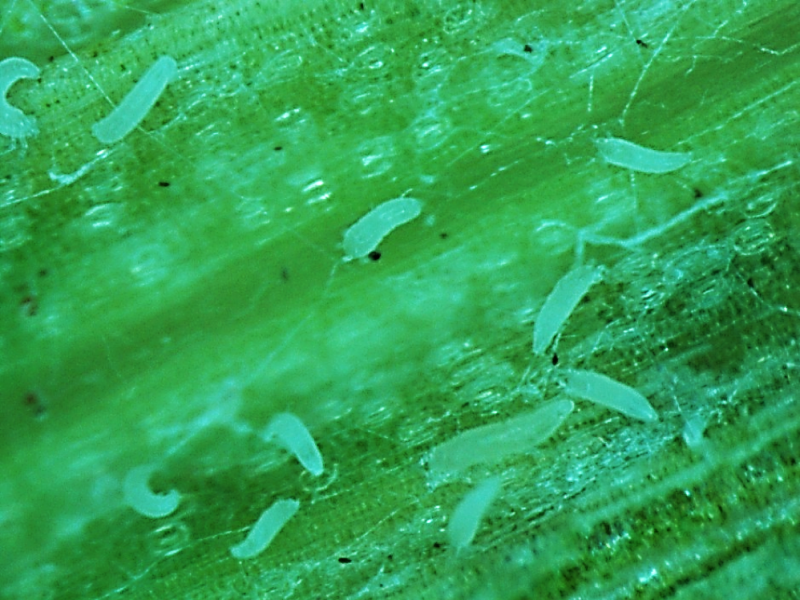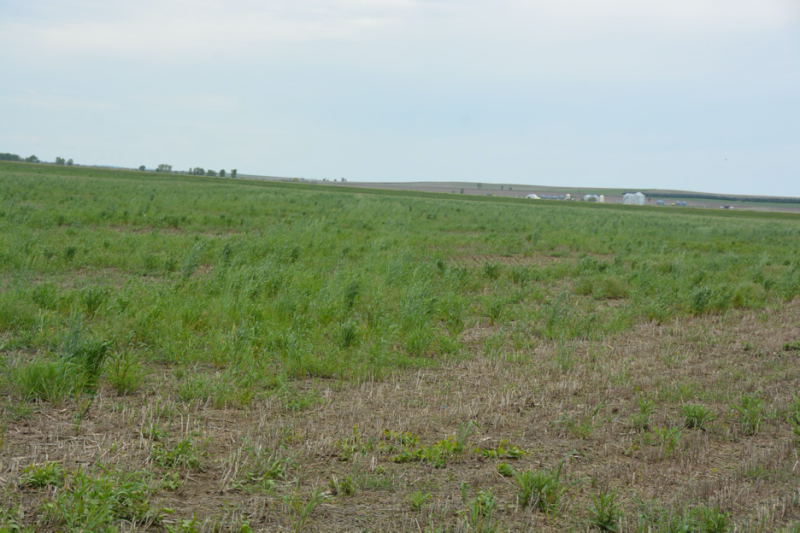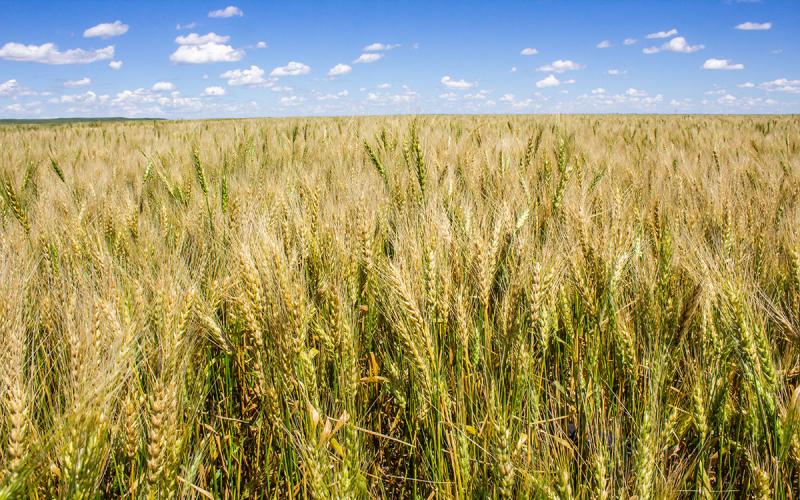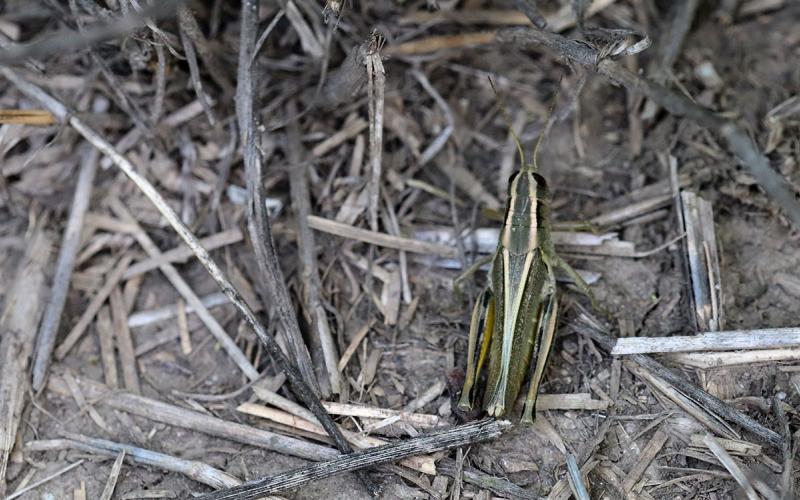
Originally Published: Aug. 14, 2020
Written with contributions by Emmanuel Byamukama, former SDSU Extension Plant Pathologist, Ruth Beck, former SDSU Extension Agronomy Field Specialist, and Marie Langham.
Wheat streak mosaic disease (WSMD) is one of the important diseases in winter wheat and can lead to severe yield losses. Sometimes, loss of an entire field occurs when the crop is not harvestable due to stunting and sterile wheat heads (Figure 1). However, WSMD can be effectively managed using cultural practices before planting. It is important to understand the inoculum source, risk factors for WSMD development, and proactive steps to manage WSMD.
Wheat streak mosaic disease is caused by a plant virus called Wheat streak mosaic virus (WSMV). This virus is transmitted by wheat curl mites, which are very small. Wheat curl mites can only be seen under high (at least 10x) magnification (Figure 2).

Wheat curl mites do not have wings but instead move from field to field by wind. Because of this, their movement is limited to wheat fields located in proximity to one another. Wheat curl mites are active in the fall and WSMV transmission that occurs shortly after winter wheat emergence until dormancy, typically results in the greatest yield losses

Risk factors for WSMD
The number one risk factor for WSMD is volunteer wheat and grassy weeds that are present in the field or adjacent fields prior to planting. WSMV can only survive in living tissue and wheat curl mites must feed on infected plants to acquire the virus. Therefore, the number one risk factor for Wheat streak mosaic virus outbreaks is the presence of over-summering hosts (volunteer wheat, grassy weeds) that ensure the survival of both the virus and wheat curl mites (Figure 3). The over-summering hosts are also referred to as the “green bridge” because they provide a home for the WCM’s between harvest and planting of fall-sown winter wheat. Hail events which lead to grain shattering may increase the presence of early volunteer wheat emergence. The volunteer wheat resulting from the hail event is likely to become infected with WSMV and will be a host for wheat curl mites and a subsequent reservoir of WSMV for the newly emerging winter wheat crop.
Another risk factor for WSMV is the time of planting and fall temperatures. If planting is done early, prior to mid-September, chances increase for WSMV infections to take place. This is because of direct movement by the wheat curl mites from recently harvested spring wheat and other small grains and grassy weeds in the area. Mild temperatures through October encourage active movement of wheat curl mites. Once the wheat curl mites have established on wheat during the fall, they will survive the winter as eggs, nymphs or adults protected inside the leaf whorls near the crown. They are capable of surviving harsh winter conditions. The following spring, as wheat greens up, the wheat curl mites become active and multiply. Overcrowding of the mites on leaves is thought to be one of the factors which leads to their dispersal in spring, and this can lead to new infections stemming from fall infections. The impact of spring infections on yield is dependent on the population density of wheat curl mites in adjacent areas. In areas where hosts are present, significant yield losses may occur.
Management of Wheat streak mosaic
Wheat streak mosaic virus and other viruses transmitted by wheat curl mites are best managed through cultural practices performed before planting. Unlike fungal diseases, nothing can be sprayed on virus-infected plants to prevent or cure virus infection. However, several practices can be used to prevent or reduce the chances of wheat getting infected by WSMV.
- Destroy volunteer wheat and grassy weeds before planting this fall. Volunteer wheat and grassy weeds are the most important risk factor for the wheat streak mosaic disease. Volunteer wheat and grassy weeds should be destroyed at least two weeks before planting. This period ensures that these hosts are completely desiccated hence eliminating wheat curl mites. If an area is known to have WSMV outbreaks, control of volunteer wheat and grassy weeds would require a communal effort because WCMs can be blown from neighboring fields up to 2 miles. Volunteer wheat and grassy weeds can be destroyed through tillage or herbicide application.
- Delay winter wheat planting for areas with known high WSMV outbreaks. Planting early in fall increases the risk of WCMs landing and transmitting viruses in emerging winter wheat. Delayed planting also ensures that summer crops will have matured and dried down hence reducing the chances of wheat curl mites moving from these crops to newly planted winter wheat.
- Plant wheat varieties that are resistant/tolerant to WSMV. Some winter wheat varieties show consistent differences between wheat varieties in terms of grain yield, reduced symptoms, and extent of virus replication in a cultivar. Rating of varieties against WSMV and other diseases can be found here.
- Practice crop rotation. The wheat curl mites can survive on other cereal crops like corn, millet, barley, and sorghum. Therefore, for areas with frequent WSMV epidemics, planting non host broad leaf crops like field peas, lentils, sunflower etc. will help keep WSMV pressure low.
The wheat curl mites only die out if they do not have hosts like volunteer wheat or other grassy hosts. They do not die out during the winter. Therefore, in situations where these volunteer grassy hosts overwinter, spring wheat planted into or near those areas in the spring can also be at risk of infection. Eliminating volunteer winter wheat and other grassy weed species that could host wheat curl mites two weeks prior to planting winter wheat is an important step in reducing the risk of this viral disease. However, fields being planted back to spring wheat next spring should also be cleaned up in the fall.


